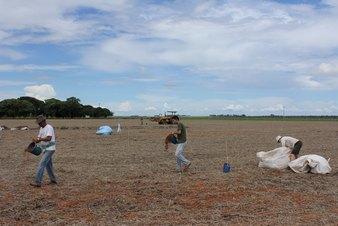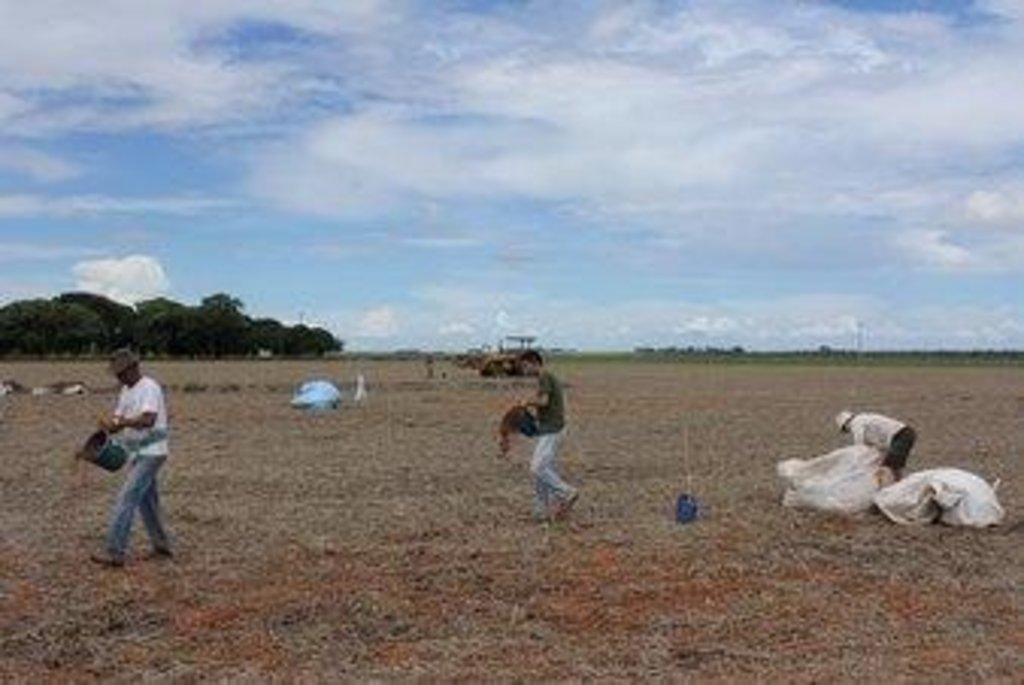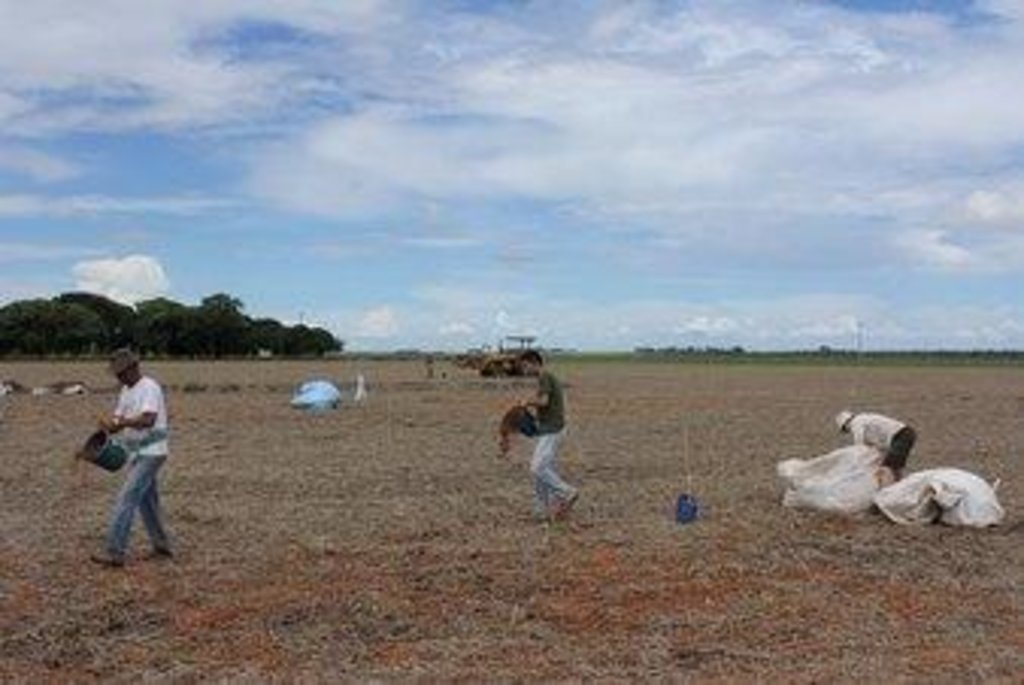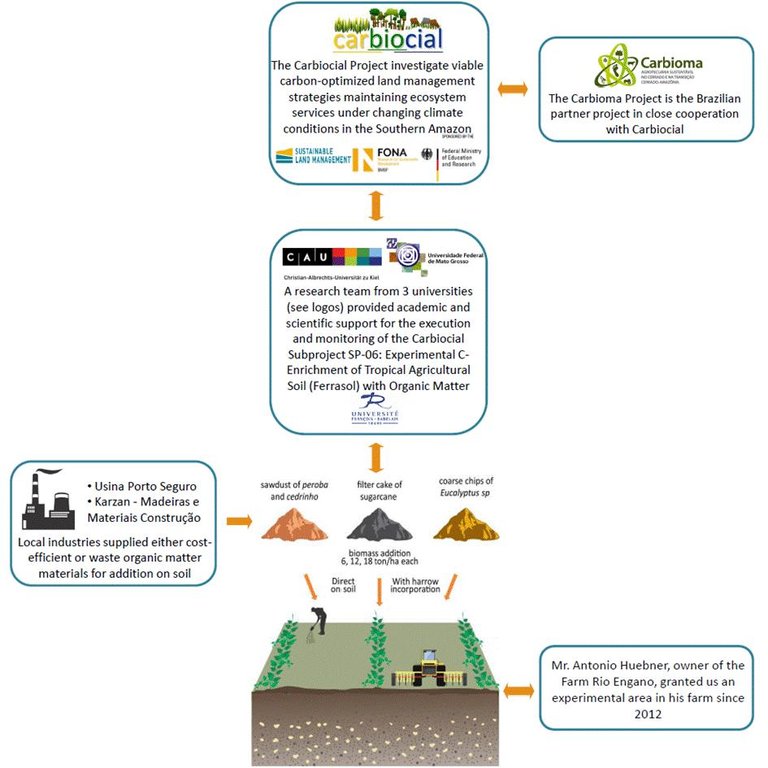Enrichment of Tropical Agricultural Soil with Organic Matter [Brazil]
- Creation:
- Update:
- Compiler: Luisa F. Vega
- Editor: –
- Reviewer: Fabian Ottiger
Enriquecimento de solo de lavoura com matéria orgânica
approaches_2541 - Brazil
View sections
Expand all Collapse all1. General information
1.2 Contact details of resource persons and institutions involved in the assessment and documentation of the Approach
SLM specialist:
SLM specialist:
Wantzen Karl
karl.wantzen@univ-tours.fr
CNRS UMR CITERES University of Tours
37200 Tours, France
France
Name of project which facilitated the documentation/ evaluation of the Approach (if relevant)
Carbon optimized land management strategies for southern Amazonia (CARBIOCIAL / GLUES)Name of the institution(s) which facilitated the documentation/ evaluation of the Approach (if relevant)
Georg August Universität Göttingen (Georg August Universität Göttingen) - GermanyName of the institution(s) which facilitated the documentation/ evaluation of the Approach (if relevant)
Christian Albrechts Universität zu Kiel (CAU) - GermanyName of the institution(s) which facilitated the documentation/ evaluation of the Approach (if relevant)
François Rabelais University Tours - FranceName of the institution(s) which facilitated the documentation/ evaluation of the Approach (if relevant)
Universidade Federal de Mato Grosso (Universidade Federal de Mato Grosso) - Brazil1.3 Conditions regarding the use of data documented through WOCAT
When were the data compiled (in the field)?
01/01/2011
The compiler and key resource person(s) accept the conditions regarding the use of data documented through WOCAT:
Yes
1.4 Reference(s) to Questionnaire(s) on SLM Technologies
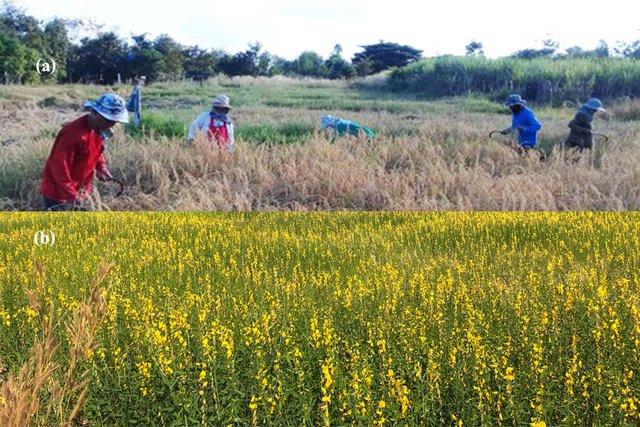
Use of Organic Fertilizers for Organic Crop Pproduction … [Thailand]
The organic farming was initiated by a group of Yasothon farmers since 1989 to produce organic rice and vegetables. The organic fertilizers used are the compost made from farm products and animal dungs, bio-fermented liquid from kitchen wastes and crotalaria as green manure.
- Compiler: Suwannapa B00njongrak
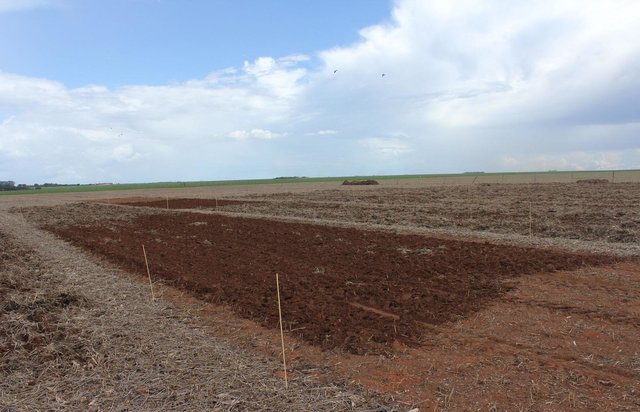
Carbon-enrichment of tropical agricultural soil with organic matter [Brazil]
Carbon-enrichment of tropical agricultural soils with locally available organic matter in the Cerrado agricultural landscape, Brazil.
- Compiler: Luisa F. Vega
2. Description of the SLM Approach
2.1 Short description of the Approach
Enrichment of tropical agicultural soils with local available organic matter in the cerrado agroscape, Brazil.
2.2 Detailed description of the Approach
Detailed description of the Approach:
Aims / objectives: Use local available organic matter (OM) to enrich Tropical agricultural soil (Ferrasol) as a strategy for sustainanle land use to improve efficiently soil fertility and/or crop production in the Brazilian Cerrado agroscape. The applied OMs are either cost-efficient or waste materials from nearby industrial suppliers.
Methods: We applied three different types of OM amendments. They include (a) Filter cake of sugarcane residues (Saccharum officinarum from alcohol/sugar-production, (b) sawdust of Peroba and Cedrinho (Peroba jaune and Erisma uncinatum, respectively) and (c) coarse chips of Eucalyptus sp.
We added 0 (control), 6, 12 and 18 tons of each amendment per hectare; using two disposition methods: direct on the soil and with harrow incorporation. Each treatment was done in triplicate. Subsequent to the first amendment application; there have not been further experimental OM additions. The experimental site was not fenced to allow the land user to continue with their arable field routines on all treatment plots.
By sampling soil and biomass, we have assessed the effect of OM addition on soil organic carbon, nutrients, water holding capacity and crop (soy and corn biomass and grain) production, after one, two and three years of a single application.
Stages of implementation: The experiment was set up in February 2012. The last soil and biomass sampling was carried out in February-March 2015.
Role of stakeholders: Mr. Antonio Huebner, owner of the Farm Rio Engano, provided us an experimetal area in his farm.
The local industies supplied the applied OM amendments.
Professors and researchers from the Christian-Albrechts University of Kiel (CAU Kiel), Federal University of Mato Grosso (UFMT) and François Rabelais University have given academic and scientifical support to the approach.
Other important information: From our outcomes, we intend to provide information for the development of soil C-enrichment schemes and carbon-friendly landscape management programs for land users, applying local resources in the Brazilian Cerrado.
2.3 Photos of the Approach
2.5 Country/ region/ locations where the Approach has been applied
Country:
Brazil
Region/ State/ Province:
Mato Grosso
Further specification of location:
Campo Verde
2.6 Dates of initiation and termination of the Approach
Indicate year of initiation:
2011
Year of termination (if Approach is no longer applied):
2016
2.7 Type of Approach
- project/ programme based
2.8 Main aims/ objectives of the Approach
The Approach focused mainly on SLM with other activities (crop production)
We aim to identify a feasible combination of types, amounts and disposition methods of OM amendments to improve efficiently soil fertility, carbon stock and/or crop production in the Brazilian Cerrado agroscape.
The SLM Approach addressed the following problems: Croplands have shown a reduction of organic matter, due to some traditional agricultural practices, such as soil plowing and tillage. These practices break down soil aggregates and expose organic matter to microbial decomposition, causing its loss to the atmosphere by mineralization (Zech et al. 1997; Tivet et al. 2013). It is especially critical in soil (Ferrasol) from the Brazilian Cerrado, as its OM content is relatively low, and tropical temperatures and humidity accelerate microbial activity (Price and Sowers 2004).
2.9 Conditions enabling or hindering implementation of the Technology/ Technologies applied under the Approach
legal framework (land tenure, land and water use rights)
- enabling
The existing land ownership, land use rights / water rights greatly helped the approach implementation: Mr Antonio Huebner, land owner and user, grant us an area to implement the approach. In this area we were able to work for more than three years.
knowledge about SLM, access to technical support
- hindering
There is not specific machinery for OM addition to soil. With the help of a bulldozer and farm workers, the OM amendments were distributed in the experimental plots. However, it increases the human workload required.
Treatment through the SLM Approach: Designing or adapting machinery for this purpose. For fine particulate organic matter, the machinery used for soil liming can be used. For larger particles (wood or bark chips), machinery commonly used for mulch application can be used. However, tests with these machineries and evtl. improvement of the application method is desireable.
workload, availability of manpower
- hindering
Treatment through the SLM Approach:
3. Participation and roles of stakeholders involved
3.1 Stakeholders involved in the Approach and their roles
- local land users/ local communities
The farm owner where the soil C-Enrichment was done
- SLM specialists/ agricultural advisers
SLM specialists from the CAU University of Kiel, Federal University of Mato Grosso and François Rabelais University
- national government (planners, decision-makers)
- international organization
Carbiocial Project
3.2 Involvement of local land users/ local communities in the different phases of the Approach
| Involvement of local land users/ local communities | Specify who was involved and describe activities | |
|---|---|---|
| initiation/ motivation | self-mobilization | Carbiocial Project |
| planning | interactive | Carbiocial Project. Scientific team of the Subproject 06 (SP-06: Experimental C-Enrichment of Tropical Agricultural Soil With Organic Matter) and land owner and user |
| implementation | interactive | Carbiocial Project (SP-06) and land owner and user |
| monitoring/ evaluation | interactive | Carbiocial Project (SP-06) and land owner and user |
| Research | self-mobilization | Carbiocial Project |
3.3 Flow chart (if available)
Description:
Organisation/flow chart of the experimental C-Enrichment of Tropical agricultural soil with organic matter amendments and monitoring (2012-2015) at the Farm Rio Engano, Brazilian Cerrado.
Author:
Luisa F. Vega (luisa.vega@gmail.com)
3.4 Decision-making on the selection of SLM Technology/ Technologies
Specify who decided on the selection of the Technology/ Technologies to be implemented:
- mainly SLM specialists, following consultation with land users
Explain:
Decisions on the method of implementing the SLM Technology were made by mainly by SLM specialists with consultation of land users
4. Technical support, capacity building, and knowledge management
4.1 Capacity building/ training
Was training provided to land users/ other stakeholders?
Yes
Specify who was trained:
- land users
4.2 Advisory service
Do land users have access to an advisory service?
Yes
Specify whether advisory service is provided:
- on land users' fields
Describe/ comments:
Name of method used for advisory service: Direct communication by visiting the land user; Key elements: Dialogue, Exchange of ideas
Advisory service is very adequate to ensure the continuation of land conservation activities; The extension system is very adequate to ensure continuation of activities. The research staff from the Soil and Rural Eng. Department, Federal University of Mato Grosso, Brazil have participated in this approach and plan to continue with research and monitoring activities.
4.3 Institution strengthening (organizational development)
Have institutions been established or strengthened through the Approach?
- yes, greatly
Specify the level(s) at which institutions have been strengthened or established:
- local
Specify type of support:
- capacity building/ training
- equipment
Give further details:
In the frame of the Carbiocial Project, several students from the UFMT carried out their master or PhD thesis and undergraduate student got practical experience. Particularly, in SP-06 one student got his master degree. Different equipments were also donate to this university.
4.4 Monitoring and evaluation
Is monitoring and evaluation part of the Approach?
Yes
Comments:
bio-physical aspects were ad hoc monitored by project staff through observations; indicators: Experimental site observation during sampling campaings by Carbiocial
bio-physical aspects were regular monitored by project staff through measurements; indicators: Regularly sampling campaings of soil and biomass
economic / production aspects were ad hoc monitored by project staff through observations; indicators: Ideas exchange with land user
economic / production aspects were regular monitored by project staff through measurements; indicators: assessment of grain and biomass crop production
There were no changes in the Approach as a result of monitoring and evaluation
There were no changes in the Technology as a result of monitoring and evaluation
4.5 Research
Was research part of the Approach?
Yes
Give further details and indicate who did the research:
A detailed study on the enrichment effects of different organic matter types on soil carbon enrichment was undertaken (laboratory analysis of field samples). Further topics covered include sustainable land management and crop production.
By research staff from the Department of Applied Ecology, Institute for Ecosystem Research, CAU university of Kiel,
Germany; the Soil and Rural Eng. Department, Faculty of Agronomy, Veterinary Medicine, and Zootechnology (FAMEVZ),
Federal University of Mato Grosso, Cuiabá, Brazil and the Interdisciplinary Research Center for Cities, Territories,
Environment and Society (CITERES-CNRS UMR 7324), François Rabelais University, Tours, France.
Research was carried out on-farm
5. Financing and external material support
5.1 Annual budget for the SLM component of the Approach
If precise annual budget is not known, indicate range:
- 2,000-10,000
Comments (e.g. main sources of funding/ major donors):
Approach costs were met by the following donors: international (Carbiocial Project): 100.0%; private sector (Donation of OM amendments); local community / land user(s) (Granted an experimental area on agricultural soil for at least 3 years)
5.2 Financial/ material support provided to land users
Did land users receive financial/ material support for implementing the Technology/ Technologies?
Yes
If yes, specify type(s) of support, conditions, and provider(s):
Private sector provided OM amendments for soil enrichment
5.3 Subsidies for specific inputs (including labour)
If labour by land users was a substantial input, was it:
- voluntary
Comments:
The land owner and user lent machinery for OM addition to soil. He also provided when possible, accomodation and food for the Cabiocial Project stuff during the approach implementation and monitoring
5.4 Credit
Was credit provided under the Approach for SLM activities?
No
6. Impact analysis and concluding statements
6.1 Impacts of the Approach
Did the Approach help land users to implement and maintain SLM Technologies?
- No
- Yes, little
- Yes, moderately
- Yes, greatly
With this approach was demonstrated that soil organic carbon in tropical agricultural soil (Ferrasol) can be enhanced by applying local available organic matter, starting from only 6 ton/ha. Even when the studied soil has been under conservational farming practices, i.e. no-tillage, for more than 20 years.
Did the Approach empower socially and economically disadvantaged groups?
- No
- Yes, little
- Yes, moderately
- Yes, greatly
Did other land users / projects adopt the Approach?
- No
- Yes, little
- Yes, moderately
- Yes, greatly
Did the Approach lead to improved livelihoods / human well-being?
- No
- Yes, little
- Yes, moderately
- Yes, greatly
The use of industrial biomass residues in this approach is a win-win situation as a solution for organic matter waste disposition and to improve soil quality
Did the Approach help to alleviate poverty?
- No
- Yes, little
- Yes, moderately
- Yes, greatly
6.2 Main motivation of land users to implement SLM
- increased production
- environmental consciousness
6.3 Sustainability of Approach activities
Can the land users sustain what has been implemented through the Approach (without external support)?
- yes
If yes, describe how:
• OM addition to tropical agricultural soil (Ferrasol) can increase significantly soil organic carbon and water retention, even in small amounts such as 6 ton/ha
• Biomass reapplication should be done in 2 years intervals
• The biomass type and disposition method did not have a significant effect on increasing soil organic carbon
6.4 Strengths/ advantages of the Approach
| Strengths/ advantages/ opportunities in the land user’s view |
|---|
| The approach improves soil quality and could enhance crop resilience in dryer years. |
| Strengths/ advantages/ opportunities in the compiler’s or other key resource person’s view |
|---|
| As this approach uses industrial biomass residues, we consider it a win-win solution for organic matter waste disposition and to improve soil quality. (How to sustain/ enhance this strength: The costs of transport and application can limit the extensive use of soil organic matter enrichment practices among land users in the Brazilian Cerrado. Therefore, subsidies could contribute to the adoption of this approach by a broader number of farmers.) |
6.5 Weaknesses/ disadvantages of the Approach and ways of overcoming them
| Weaknesses/ disadvantages/ risks in the land user’s view | How can they be overcome? |
|---|---|
| The costs of OM transport and application | Mr. Antonio Huebner, the land owner and user in this approach, has been cultivating with soybean and corn rotation under conservational farming practices, i.e. no-tillage, for more than 20 years. He thinks a possible more economic alternative for this approach is to create soy and corn varieties which have more abundant foliage and the same capacity of grain production. In an approach that combines these varieties and no-tillage, the farmers could continue cultivating in their traditional way, without having to incur in extra costs due to application of OM amendments; however, increasing organic matter inputs to the soil. |
| Weaknesses/ disadvantages/ risks in the compiler’s or other key resource person’s view | How can they be overcome? |
|---|---|
| Lack of adequate machinery for OM addition | Designing or adapting machinery for this purpose. |
7. References and links
7.1 Methods/ sources of information
- field visits, field surveys
- interviews with land users
7.2 References to available publications
Title, author, year, ISBN:
Price PB, Sowers T (2004) Temperature dependence of metabolic rates for microbial growth, maintenance, and survival. Proceedings of the National Academy of Sciences of the United States of America 101:4631–4636
Title, author, year, ISBN:
Tivet F, De Moraes Sa JC, Lal R, Briedis C, Borszowskei PR, Bürkner dos Santos J, Farias A, Eurich G, Da Cruz Hartman D, Nadolny Junior M, Bouzinac S, Séguy L (2013) Aggregate C depletion by plowing and its restoration by diverse biomass-C inputs under no-till in sub-tropical and tropical regions of Brazil. Soil and tillage research, 126 :203-218
Title, author, year, ISBN:
Zech W, Senesi N, Guggenberger G, Kaiser K, Lehmann J, Miano TM, Miltner A, Schroth G (1997) Factors controlling humific G. ation and Mineralization of soil organic matter in the tropics. Geoderma 79 : 117-161
Links and modules
Expand all Collapse allLinks

Use of Organic Fertilizers for Organic Crop Pproduction … [Thailand]
The organic farming was initiated by a group of Yasothon farmers since 1989 to produce organic rice and vegetables. The organic fertilizers used are the compost made from farm products and animal dungs, bio-fermented liquid from kitchen wastes and crotalaria as green manure.
- Compiler: Suwannapa B00njongrak

Carbon-enrichment of tropical agricultural soil with organic matter [Brazil]
Carbon-enrichment of tropical agricultural soils with locally available organic matter in the Cerrado agricultural landscape, Brazil.
- Compiler: Luisa F. Vega
Modules
No modules


